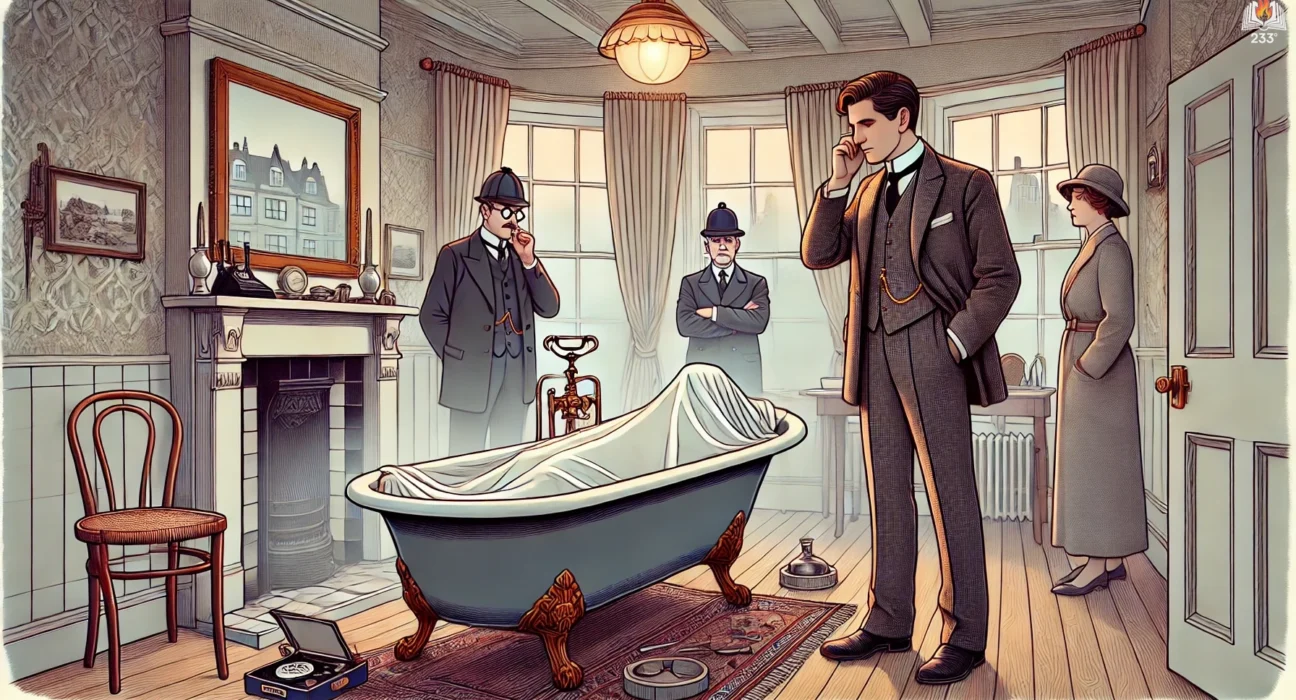Whose Body? is the debut novel of Dorothy L. Sayers, published in 1923. It introduces the character of Lord Peter Wimsey, an aristocratic amateur sleuth, whose charm, wit, and intellectual curiosity drive his passion for solving mysteries. The story revolves around the discovery of a corpse found in a bathtub, wearing only a pair of pince-nez. Lord Peter is drawn into the investigation, using his unconventional methods and sharp intellect to untangle a complex case of murder, identity, and deception.
Plot Summary
On a foggy morning in London, Lord Peter Wimsey, an aristocratic and whimsical amateur sleuth, is interrupted from a book sale by his mother, the Dowager Duchess of Denver, with curious news. An architect, Mr. Alfred Thipps, has discovered a dead body in his bathtub in his Battersea flat, completely naked except for a pair of pince-nez perched on its nose. Intrigued by the bizarre situation, Lord Peter decides to investigate, delighting in the prospect of an intellectual puzzle.
Thipps is a mild-mannered, nervous man, clearly disturbed by the body’s appearance in his flat. Despite Inspector Sugg’s immediate suspicion of Thipps, Lord Peter is unconvinced. The inspector’s methods strike him as simplistic, and Lord Peter, with the help of his astute valet Bunter, sets out to uncover the truth.
Meanwhile, another mystery grips London’s upper society: the sudden disappearance of Sir Reuben Levy, a prominent financier. Sir Reuben vanished from his home without a trace, leaving his wife and household in confusion. The connection between these two seemingly unrelated events begins to take shape in Lord Peter’s mind. Could the body in Thipps’s bath be that of the missing financier? The police, particularly Inspector Sugg, are quick to assume so, but Lord Peter’s instincts tell him that the situation is far more complex.
Lord Peter’s investigation leads him to question Mr. Thipps and his servant, Gladys, both of whom provide flimsy alibis. Still, Lord Peter remains convinced of their innocence. He visits the crime scene at Queen Caroline Mansions, where he examines the body with Bunter. Lord Peter is struck by several strange details: the body’s impeccable grooming, despite being naked, and the fact that the pince-nez found on the body seem entirely out of place.
Across town, in Sir Reuben Levy’s house, Inspector Charles Parker, a close friend of Lord Peter’s and a Scotland Yard detective, is investigating the financier’s disappearance. Levy was last seen returning home after dinner with friends, but by the morning, he had vanished, leaving behind his clothes, his wallet, and even his spectacles. The two cases appear to be linked by the shared peculiarity of missing clothing, yet Lord Peter and Parker remain cautious about drawing conclusions too soon.
As the investigation progresses, Lord Peter meets with Sir Julian Freke, a distinguished neurologist and surgeon at St. Luke’s Hospital, which happens to be near Thipps’s residence. Freke is an imposing figure, sharp-witted and highly respected in his field. He provides some insight into the body’s condition but seems otherwise uninterested in the case. Yet something about Freke’s demeanor and his proximity to both Thipps’s flat and the hospital piques Lord Peter’s curiosity.
Diving deeper into Sir Reuben’s past, Lord Peter uncovers a complex web of business dealings and enemies, but none seems likely to be connected to the body in the bath. However, as Lord Peter reexamines the evidence, he begins to see a pattern emerging, one that points to an elaborate cover-up. The missing man and the dead body are tied together by more than just coincidence.
Lord Peter’s sharp eye for detail reveals that the dead body found in Thipps’s bath does not match Sir Reuben Levy. While the police had hastily identified the corpse as Levy’s due to superficial similarities, Lord Peter notices crucial differences in physical features and age. The dead man, it appears, was not Levy at all but someone else entirely—a man of lower social standing, possibly homeless, whose body had been meticulously groomed to resemble the missing financier.
The investigation takes a sinister turn when Lord Peter delves into Sir Julian Freke’s background. He discovers that years ago, Freke had been involved in a bitter rivalry with Sir Reuben Levy over a woman. Freke’s cold intellect and desire for revenge suggest a dark motive. Could Freke have orchestrated the entire plot to both kill Levy and dispose of another body in such a way as to confuse the authorities?
As the pieces fall into place, Lord Peter and Parker confront Freke with their suspicions. In a chilling confession, Freke reveals the depths of his manipulation. He had indeed murdered Sir Reuben Levy, driven by long-standing animosity. Using his medical expertise, Freke had carefully disguised another man’s body—one he had taken from the hospital morgue—and placed it in Thipps’s bath, knowing it would throw off the investigation. He had intended for the body to be mistaken for Levy, while he secretly disposed of Levy’s real body in the river, believing that no one would be able to trace the crime back to him.
Freke’s meticulous planning had almost succeeded, but Lord Peter’s keen observation and relentless pursuit of the truth foiled the plot. The pince-nez, which initially seemed like an incongruous detail, had been a key mistake. Freke had planted them on the corpse, but they were far too distinctive to belong to a man like Sir Reuben Levy, and their presence aroused Lord Peter’s suspicion.
In the end, Freke is arrested for his crimes, his cold genius undone by the very attention to detail that had once served him so well. The case is solved, and Sir Reuben’s body is recovered from the river. Thipps and Gladys are cleared of any wrongdoing, much to their relief, and the sensational case concludes with Lord Peter reflecting on the nature of crime, guilt, and justice.
Though the case leaves him with a sense of accomplishment, it also triggers a deeper, more personal response. Lord Peter, haunted by his experiences during the war, struggles with bouts of shell shock, and the dark complexities of the case remind him of the fragility of the human mind. In the quiet aftermath, he returns to his books, finding solace in the intellectual pursuit that always draws him back to the world of crime.
Main Characters
- Lord Peter Wimsey: The novel’s protagonist, Lord Peter is an aristocrat with a keen interest in criminal investigation. His polite, whimsical demeanor hides a brilliant mind and a deep passion for solving mysteries. As the case progresses, his intellectual prowess and ability to see details others overlook make him a force to be reckoned with.
- Bunter: Lord Peter’s loyal valet and assistant, Bunter is not only adept at traditional butler duties but also highly skilled in photography, forensics, and investigative work. His attention to detail and efficiency complement Lord Peter’s style of investigation.
- Inspector Sugg: A police inspector who resents Lord Peter’s involvement in criminal cases, Sugg is portrayed as somewhat bumbling and often fails to appreciate the complexities of the investigation.
- Mr. Alfred Thipps: An architect who finds the mysterious body in his bathtub. Nervous and mild-mannered, he is initially a suspect in the case, though it becomes clear he is not involved.
- Sir Reuben Levy: A wealthy financier who disappears mysteriously, leading to speculation about whether his body is the one found in Thipps’s bathtub.
Theme
- Identity and Disguise: The central mystery revolves around the identity of the corpse found in the bathtub. Throughout the novel, Sayers explores how appearances can be deceiving, both in the literal and figurative sense, as characters’ motives and identities are questioned.
- Class and Social Commentary: Lord Peter’s aristocratic background provides a contrast to the working-class characters like Thipps. Sayers subtly critiques social divisions and expectations, especially in how different characters are treated by the police and society based on their status.
- The Role of the Detective: Lord Peter’s approach to solving the mystery highlights the intellectual, almost artistic side of detective work. He enjoys the process of deduction and is portrayed as a “gentleman detective” who uses his leisure and resources to pursue justice.
- Psychological Depth: Though the book is a light-hearted mystery, it touches on the psychological consequences of war, as Lord Peter’s experiences in World War I surface through his occasional bouts of shell shock and insomnia.
Writing Style and Tone
Dorothy L. Sayers’ writing style in Whose Body? is witty, erudite, and conversational. The dialogue, particularly Lord Peter’s, is filled with humor, irony, and a light, playful tone that balances the darker elements of the murder mystery. Sayers often uses her protagonist’s speech to showcase his intelligence and charm, as well as to gently satirize the British upper class. The tone is generally light-hearted, even whimsical, though there are moments where the seriousness of the crime and its psychological toll become apparent.
Sayers also weaves in technical details about detective work and forensics, giving a sense of realism to the investigative process. The narrative is tightly controlled, with clues meticulously laid out for both the reader and Lord Peter to uncover. Her ability to blend intellectual puzzles with human drama makes the novel more than just a standard whodunit, instead offering a deeper exploration of character and society.
We hope this summary has sparked your interest and would appreciate you following Celsius 233 on social media:
There’s a treasure trove of other fascinating book summaries waiting for you. Check out our collection of stories that inspire, thrill, and provoke thought, just like this one by checking out the Book Shelf or the Library
Remember, while our summaries capture the essence, they can never replace the full experience of reading the book. If this summary intrigued you, consider diving into the complete story – buy the book and immerse yourself in the author’s original work.
If you want to request a book summary, click here.
When Saurabh is not working/watching football/reading books/traveling, you can reach him via Twitter/X, LinkedIn, or Threads
Restart reading!








